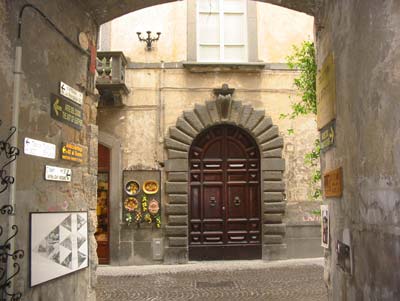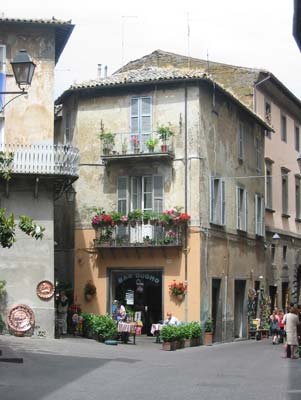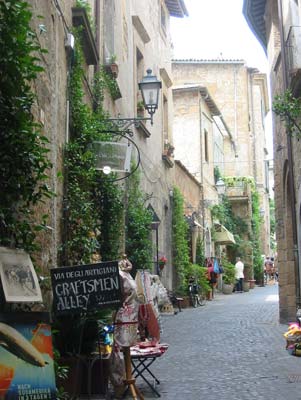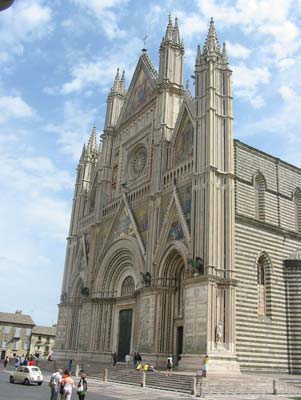Orvieto — fine wine blends with medieval splendor
M. Lewis Stein, Irvine, CA
Surveying the drab station and its equally unimpressive surroundings as we alighted from the train at Orvieto, my wife, Barbara, queried, “So, where is the picturesque village you promised me?”
“Not yet,” I replied as I led her a few steps to the funicular that was to haul us to the central part of the hill town of some 20,000 people located between Rome and Florence in the Paglia River Valley.
To the cathedral
Weary of Rome’s tourist glut and car-choked streets, we fled to Orvieto, in Umbria, which I had visited alone in the 1990s. Now, along with a clutch of other travelers, we paid 60¢ for the cable ride that stopped about 200 yards short of the town. From there, we piled into a minibus that took us the rest of the way (no charge).
The transports have replaced the mules that once carried visitors and locals up the 3,300-foot slope to the ancient city, which began as an important Etruscan center. In Roman times, Orvieto was noted for its ceramics production, a craft still practiced in the village.
We were deposited in front of the town’s famed cathedral, whose unique facade draws more attention than its interior. Visitors stand on the Piazza Duomo, staring in fascination at the multicolored Gothic edifice whose construction began in the 13th century.
The triple-gabled front is designed in four polygonal piers that mimic the church’s nave and two aisles. Bas reliefs (which are considered masterpieces) by unknown artists represent the origin of man, the mystery of redemption and man’s final destiny. This sight is enhanced when the sun hits the cathedral in full force. Convenient benches on the square offer a place for longer viewing.
Exploring Orvieto
Tearing ourselves away from the scene, we began our wandering through Orvieto’s narrow, twisting streets, taking a stroll back in time. With its sheer cliffs and arched gates into the city, Orvieto resembles a fortress, which indeed it was in the 13th and 14th centuries. Several of the ancient arched portals remain, as do a number of underground galleries, tunnels, cisterns and cellars.
We declined the opportunity to walk down the 248-step corkscrew staircase to the caverns below. I had, to my satisfaction, tested my stamina several months earlier while struggling to the top of Mont-St-Michel in France — 282 steps, each one of which I counted.
We began our walk on the Via Cavour, the main street, which leads to the Piazza della Repubblica, the most outstanding of Orvieto’s many plazas and once the site of Etruscan and Roman forums. History was all around us. Not far away sits the Torre del Moro, an imposing tower built by a wealthy family. It eventually became known as Torre del Papa (the Pope’s Tower), becoming part of the papal palace in the 17th century.
If you stroll the streets long enough you will eventually encounter Orvieto’s two main gates, Porta Soliana (aka Porta Rocca) and Porta Maggiore. Both are adorned with statues of Pope Boniface VIII, who, it is said, entered the city through the first and departed from the latter.
A few recommendations
Orvieto has eight churches. If you’re pressed for time, pick San Giovenale, which offers exquisite frescoes and a spectacular view of the countryside with its farmhouses, monasteries and vineyards.
When descending from the town, you can get a second view of the valley from an outlook near the railway station.
If time is not an imperative, visit the Chapel of San Brizio, inside Orvieto’s cathedral, for its spectacular “Doomsday,” or “End of the World,” fresco by famed Renaissance artist Luca Signorelli. Finished in 1503, the painting is reputed to mark the end of the Middle Ages and the beginning of the modern age.
The fresco is history foretold: in the 16th century, the city underwent a makeover that included the construction of neoclassical private and public buildings by such celebrated architects as Giuseppe Valadier and Virginio Vespignani.
The question of what to buy in Orvieto becomes an easy one when meandering along its streets with their medieval and neoclassic-styled buildings. From the sixth century, the hamlet has been known for its ceramic and bronze work, and the craft has been carried on. A number of small shops feature hand-painted ceramic plates, bowls, candlesticks and other objects in modern or traditional designs.
Shoppers also can find handmade jewelry, leatherwork, woodcarvings and Orvieto’s distinctive lace. Caroli, a store across from the duomo, has an ample stock of souvenirs and elegant artwork.
I liked a ceramic painting of a local hillside scene displayed outside another store, but the owner had taken off for the time-honored riposo, a long afternoon break. When I returned an hour or so later, the shop was open but the painting had been sold.
Examples of Orvieto’s distinctive crafts can be found at two local museums, the Archeologica Nazionale and dell’Opera del Duomo. A wine and handicrafts fair is held in the hill town each August.
We stopped for an outdoor lunch at Café Duomo in the center of town. It was a perfect spot for people-watching, located at the junction of Cavour and Via del Duomo. We ate delightful pizza on thick slices of focaccia bread and drank the city’s renowned wine.
The vines grow from a soil of clay and volcanic ash, giving the resulting wine a singular flavor. It comes in secco, or dry, and abboccato, which is somewhat sweet. Shops sell it in bottles packaged for traveling. Tastings of the various varieties are offered at the Consorizo Tutela Vini di Orvieto at 36 Via Cavour.
We spent about five hours in town, but it was enough time to prompt Barbara to ask, “When are we coming back?”
Getting there
Orvieto can be reached by rail in about 90 minutes from Rome or Florence or by car via the Autostrada del Sole between the two cities. There is also public bus service to the town.
Orvieto has more than 20 hotels, ranging from B&Bs to 4-stars. Hotel rates range from $60 to $175. Restaurants are plentiful. We didn’t stay in town on this visit, as it’s an easy day trip destination.
Additional information is available from the Orvieto Tourist Office (Piazza Duomo 24, 05018 Orvieto, Italy; phone 390763341772 or fax 390763344433).





